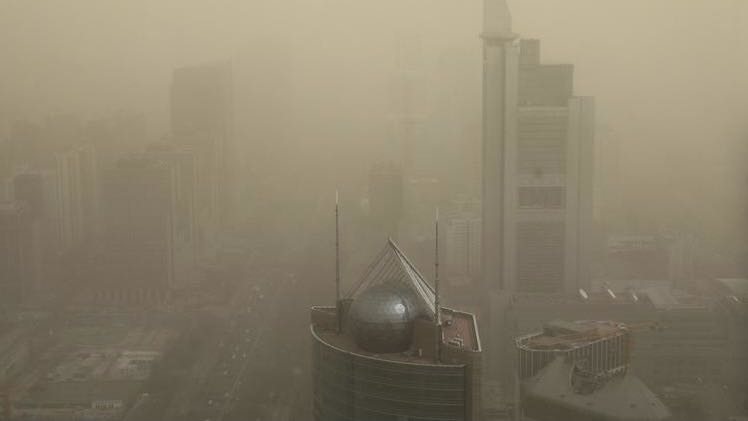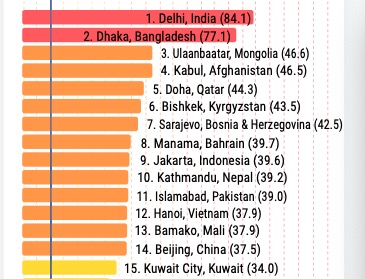
Delhi has once again been rated as the most polluted capital city in the world, despite COVID-19 lockdowns which improved air quality in many cities in 2020, said a global ranking of polluted cities released on Tuesday.
Dhaka, Ulaanbaatar, Kabul and Doha are among the world's top five most polluted capital cities, ranking second, third, fourth and fifth, respectively. Toxic air placed Bishkek (6th), Sarajevo (7th), Manama (8th) and Jakarta (9th) on the ranking list. Kathmandu, Nepal's capital city, situated at the foothills of Himalaya, rounded out the top 10.
South Asia emerged as the most polluted region, with Bangladesh, India and Pakistan sharing 42 of the 50 most polluted cities worldwide. The report also rated Delhi the most polluted capital city of the world in 2018 and 2019.
The global rankings for polluted cities, prepared by IQAir's World Air Quality Report 2020, calculates air quality based on fine particulate matter PM2.5 concentration in air. Air pollution has become one of the world's most significant health hazards, contributing to about seven million premature deaths annually.
"The year 2020 brought an unexpected dip in air pollution. In 2021, we will likely see an increase in air pollution due to human activity, again," said Frank Hammes, CEO of IQAir.
More than 80 percent of the countries ranked in the report showed improvement in air quality due to travel restrictions taken to control the spread of COVID-19. Compared to 2019, pollution levels dropped by 15 percent in Delhi, 11 percent in Beijing and 17 percent in London.
"While many cities recorded temporary improvements in air quality due to lockdowns, the health impact of burning fossil fuels remained severe. Unfortunately, Delhi continued to be the most polluted capital in the world in 2020," said Avinash Chanchal, a climate campaigner with Greenpeace India.
But the reduction in emission level resulted in only 24 out of 106 monitored countries meeting the World Health Organization (WHO) annual threshold for PM2.5 concentrations in air in 2020.
Lockdowns provided pollution experts a perfect laboratory condition to measure air pollution when most fossil fuel-powered sectors, including ground transportation and aviation, had minimal emissions.
Apart from fossil fuels, climate change also significantly affects air pollution. Wildfires in Australia, dust storms in Africa and agricultural fires in Indonesia resulting from rising temperatures released toxic gases in 2020, affecting air quality in these countries.
"Many parts of the world experienced unprecedented, but short-lived, improvements in air quality in 2020, as restrictions related to the COVID-19 pandemic caused a steep drop in fossil fuel consumption," said Lauri Myllyvirta, lead analyst at the Center for Research on Energy and Clean Air (CREA).

Top 15 most polluted capital cities in 2020. /IQAir graphics
Top 15 most polluted capital cities in 2020. /IQAir graphics
Sandstorms cause worry in China
The report was released a day after northern China witnessed the largest sandstorm in a decade, sweeping across 12 provinces.
The storm originated in Mongolia and killed nine people and injured over a dozen in the country.
The Air Quality Index (AQI) in many parts of Beijing crossed 10,000 micrograms per cubic meter on Monday, and, as a result, a low visibility led to the cancellation of more than 400 flights in and out of the Chinese capital city.
In the last five years, Beijing has curtailed PM2.5 levels by nearly 40 to 50 percent to tackle toxic air during the winter months. Still, pollutants and dust storms from neighboring provinces have become a tough nut to crack. The report ranks Beijing as the 14th most polluted city in the world.
As a result of lockdowns, 86 percent of Chinese cities experience cleaner air than the year prior, while annual PM2.5 exposure by population dropped by 11 percent.
According to researchers, sandstorms, triggered partly by climate change, could continue to worsen air quality, particularly in northwest China's Xinjiang Uygur Autonomous Region. The IQ Air's report in 2019 ranked Hotan in Xinjiang as the second most polluted city in the world because of frequent sandstorms hitting the region's cities.
Dust storms in this region are typically most severe in the spring months of March and April due to weather patterns. However, human influence in the form of land manipulation for agriculture and human-influenced climate change increasing the severity and frequency of droughts are also linked to more extreme dust storms, the report said.
"Global warming is one of the causes of sandstorms. China has already launched massive campaigns of reforestation that have reduced sandstorms, but transforming desertification hit regions into less arid places takes decades to prevent such events," Yann Boquillod, director of air quality monitoring at IQAir AirVisual, told CGTN.
(Cover: China's northern, northwestern regions and the capital city Beijing were shrouded in thick brown dust due to an invading sandstorm from Mongolia, which local weather bureau has called it the biggest sandstorm in a decade, Beijing, China, March 15, 2021. /Reuters)

